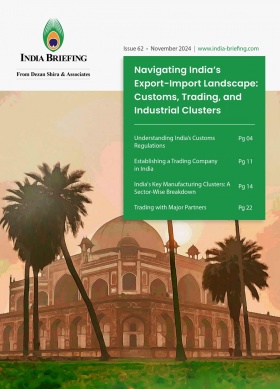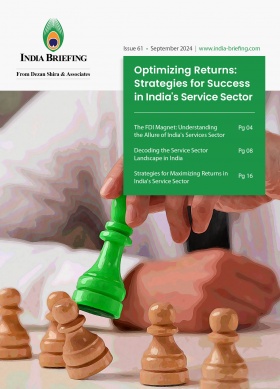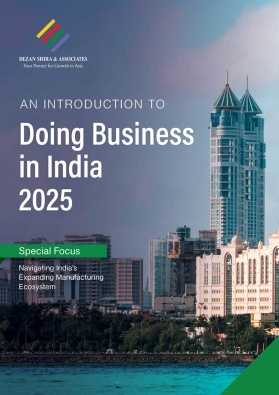India-US Relations: Key Outcomes of Modi-Trump Meet
The February 13 meeting between Indian Prime Minister Narendra Modi and US President Donald Trump at the White House Oval Office in Washington, D.C., marks another interesting juncture in the India-US partnership. The discussions covered areas such as trade, defense cooperation, energy security, space exploration, and regional security concerns. We break down some key announcements.
Indian Prime Minister Narendra Modi met with US President Donald Trump in Washington, D.C., on February 13, 2025. The latest rounds of bilateral discussions explored avenues for India-US collaboration to secure energy supplies, advance defense procurement, deepen civil nuclear cooperation, and enhance cooperation in artificial intelligence (AI) and emerging technologies.
India-US economic relations: Aiming for US$500 billion in trade by 2030
India and the US aim to double bilateral trade to US$500 billion by 2030. The US is India’s second-largest trading partner, with a trade surplus of US$23.26 billion for India as of FY2024-25 (April–November).
During their February 13 meeting, Trump and Modi agreed to initiate discussions on securing a swift trade deal and resolving their tariff issues. As part of the negotiations, New Delhi committed to increasing its purchases of US oil, gas, and military equipment. The announcements came just hours after the US president criticized the business climate for US companies in India and outlined plans for reciprocal tariffs on nations imposing duties on US imports, which would include India.
|
India-US Trade Relations Year-on-Year (Value in US$ Million) |
||||||
|
|
FY2019-20 |
FY2020-21 |
FY2021-22 |
FY2022-23 |
FY2023-24 |
FY2024-25* (Apr-Nov) |
|
India’s exports to the US |
53,088.77 |
51,623.14 |
76,167.01 |
78,542.60 |
77,515.03 |
52,894.94 |
|
India’s imports from the US |
35,819.87 |
28,888.10 |
43,314.07 |
50,863.87 |
42,195.49 |
29,632.20 |
|
Total trade |
88,908.65 |
80,511.24 |
119,481.08 |
129,406.47 |
119,710.52 |
82,527.14 |
Source: Ministry of Commerce and Industry
Note: *The India-US trade data for FY2024-25 will be released in April after the completion of the ongoing financial year, ending on March 31, 2025.
Trump tariffs and US-India trade deficit
As part of his economic policies, Trump announced a 25 percent tariff on all steel and aluminum imports, effective March 12, 2025. This move is expected to intensify global trade tensions and create challenges for steel exporters, including India.
Nomura analysts highlight that India’s weighted average effective tariff on US exports is considerably higher than the US’s tariff on Indian exports. India’s high tariff rates, averaging 17 percent compared to the US’s 3.3 percent tariff, expose it to potential retaliatory measures.
India’s food products, vegetables, textiles, and clothing sectors, could be most vulnerable to Trump’s tariff measures, according to media reports. Other major Indian exports to the US, include electrical machinery, gems and jewelry, pharmaceuticals, autos, besides iron and steel.
Tariffs, also referred to as customs duties, are taxes levied on imported goods. These duties are paid by importers to the government and are often passed on to consumers. For example, if a company imports a product worth US$100 with a 10 percent tariff, the final cost rises to US$110.
Interestingly, on February 13, India slashed its import tax (customs duty + additional levy) on bourbon imports from 150 percent to 100 percent; the US is the primary exporter of bourbon whiskey to India.
Countries impose reciprocal tariffs to counter trade barriers set by their partners. In 2018, when the US raised tariffs on Indian steel and aluminum, India responded by increasing duties on 29 US products.
The US faces significant trade deficit, particularly with China and India. In FY2023-24, its trade deficit with India reached US$35.31 billion; in 2024, the trade deficit was US$45.6 billion. To address this, the Trump administration has justified tariffs as a measure to curb imports.
Defense cooperation: F-35 fighter jets and military sales
Defense cooperation remains a key pillar of the India-US partnership, but Trump has added in a transactional component. During this latest meeting with Modi, Trump noted that the US would be keen to supply India with F-35 stealth fighter jets. This would position India among a select group of nations authorized to acquire these jets.
|
India-US Trade in Arms and Ammunition; Parts and Accessories Thereof (Value in US$ Million) |
||||||
|
|
FY2019-20 |
FY2020-21 |
FY2021-22 |
FY2022-23 |
FY2023-24 |
FY2024-25* (Apr-Nov) |
|
India’s exports to the US |
43.72 |
68.54 |
73.97 |
60.56 |
53.10 |
42.48 |
|
India’s imports from the US |
0.86 |
1.46 |
0.97 |
0.57 |
2.27 |
1.72 |
|
Total trade |
44.58 |
70 |
74.94 |
61.113 |
55.37 |
44.28 |
Source: Department of Commerce, Ministry of Commerce and Industry, GoI
Trade in arms and ammunition between the two nations has seen fluctuations over the years, but the US appears keen to expand military sales and co-production initiatives with India. This could drive technological advancements in defense manufacturing while strengthening India’s defense capabilities.
US-India COMPACT: A new initiative to strengthen defense ties
The US and India have a Major Defense Partnership, in place since 2016. In 2018, India’s status was elevated to Strategic Trade Authorization tier 1 status, allowing the country to receive license-free access to a wide range of military and dual-use technologies regulated by the Department of Commerce.
Now the two countries are set to sign a 10-year defense framework in 2025, marking a major advancement in their defense ties. This agreement would align with the initiative announced by Trump and Modi during their meeting: the US-India COMPACT (Catalyzing Opportunities for Military Partnership, Accelerated Commerce & Technology for the 21st Century), which aims to enhance cooperation in defense, trade, investment, energy security, technology, multilateral collaboration, and people-to-people ties.
Defense collaboration remains a focal point, with the US expanding its defense sales and co-production with India. The two leaders revealed plans to advance new procurements and co-production agreements this year for Javelin Anti-Tank Guided Missiles and Stryker Infantry Combat Vehicles in India.
To facilitate smoother trade and technology transfer, the US will review the International Traffic in Arms Regulations (ITAR), ensuring easier access to spare parts and in-country repairs. Additionally, negotiations will begin for a Reciprocal Defense Procurement (RDP) agreement, fostering collaboration in space, air defense, missile systems, and undersea warfare. The US is also reviewing its policy on providing India with fifth-generation fighter jets, including the F-35, and advanced undersea systems, deepening strategic defense ties.
Building on the U.S.-India Roadmap for Defense Industrial Cooperation and recognizing the growing significance of autonomous systems, the two leaders announced the launch of the Autonomous Systems Industry Alliance (ASIA) to expand industry partnerships and production in the Indo-Pacific. They welcomed a new collaboration between Anduril Industries and Mahindra Group to co-develop and co-produce advanced maritime systems and AI-enabled counter-Unmanned Aerial Systems (UAS) for regional security. Additionally, they highlighted a partnership between L3 Harris and Bharat Electronics for the co-development of active towed array systems.
The leaders also pledged to strengthen military cooperation across air, land, sea, space, and cyberspace through enhanced training, exercises, and operations, integrating the latest technologies. They welcomed the upcoming “Tiger Triumph” tri-service exercise, originally launched in 2019, which will be conducted in India at a larger scale and with increased complexity.
Furthermore, the leaders committed to advancing support for US and Indian military deployments in the Indo-Pacific by enhancing logistics and intelligence sharing. They also outlined measures to improve force mobility for joint humanitarian and disaster relief operations, alongside broader security cooperation initiatives and military exchanges.
Energy security and civil nuclear collaboration
Key discussions focused on fully implementing the India-US 123 Civil Nuclear Agreement, including plans to construct US-designed nuclear reactors in India. Both countries are also exploring small modular reactors, which would enable advanced technology transfers.
India-US collaboration on the IMEEC corridor
Trump announced that India and the US agreed to collaborate on the development of the India-Middle East-Europe Economic Corridor (IMEEC). Describing it as one of the most transformative trade routes in history, Trump highlighted that the corridor would connect India, Israel, Italy, and ultimately the US through integrated roads, railways, and undersea cables.
“The IMEEC is vital for bilateral interests, enhancing strategic supply chains and boosting security in economic, energy, and health sectors across India, Europe, and the Middle-East,” noted PM Modi following a project review with French President Emmanuel Macron earlier in the week.
During his meeting with Modi, Trump said: “We agreed to work together to help build one of the greatest trade routes in all of history. It will run from India to Israel to Italy and onward to the United States connecting our partners by ports, railways and undersea cables. Many many undersea cables.”
US wants to be a key energy supplier to India
During their joint press conference, Trump stated that India and the US reached a crucial agreement on energy, that would position the US as a leading supplier of oil and gas to India.
This would necessitate a big shift in India’s strategy for autonomy in energy supplies; currently, Russia, Iraq, Saudi Arabia, and the UAE are India’s top suppliers of oil.
Support for India’s space exploration ambitions
Expanding space exploration cooperation was another focal point of the India-US bilateral talks. The US has pledged its support for India’s ambitious goal of sending its first astronaut to the International Space Station (ISS) by 2025. Beyond human spaceflight, the two nations are also working together on the NASA-ISRO Synthetic Aperture Radar (NISAR) mission, which aims to map Earth’s surface using advanced dual radar technology. Further discussions explored future opportunities in satellite technology, space tourism, and advanced space manufacturing, reinforcing the growing synergy between both countries in space research and development.
India’s membership in the International Energy Agency (IEA)
The US has backed India’s membership in the International Energy Agency (IEA), which would reinforce India’s role in global energy governance. This move is poised to strengthen India’s influence in international energy policy making and facilitate deeper engagement in shaping the global energy landscape.
Quad cooperation and Indo-Pacific strategy
Regional security and multilateral cooperation also featured prominently in the bilateral discussions, with Modi extending an invitation to Trump for the upcoming Quad Leaders’ Summit in New Delhi. The Quadrilateral Security Dialogue (Quad), which includes India, the US, Japan, and Australia, is focused on strengthening regional security through joint initiatives, such as disaster response, maritime patrols, and interoperability exercises. Beyond the Quad, both leaders also discussed broader multilateral engagements, including the I2U2 Group, which aim to deepen cooperation in trade, defense, and energy.
About Us
India Briefing is one of five regional publications under the Asia Briefing brand. It is supported by Dezan Shira & Associates, a pan-Asia, multi-disciplinary professional services firm that assists foreign investors throughout Asia, including through offices in Delhi, Mumbai, and Bengaluru in India. Readers may write to india@dezshira.com for support on doing business in India. For a complimentary subscription to India Briefing’s content products, please click here.
Dezan Shira & Associates also maintains offices or has alliance partners assisting foreign investors in China, Hong Kong SAR, Dubai (UAE), Indonesia, Singapore, Vietnam, Philippines, Malaysia, Thailand, Bangladesh, Italy, Germany, the United States, and Australia.
- Previous Article India’s New Income Tax Bill 2025: An Overview
- Next Article Introducción a Hacer Negocios en India 2025 – Nueva Publicación Ya Disponible









